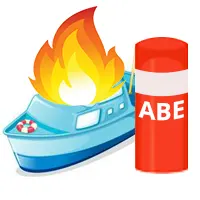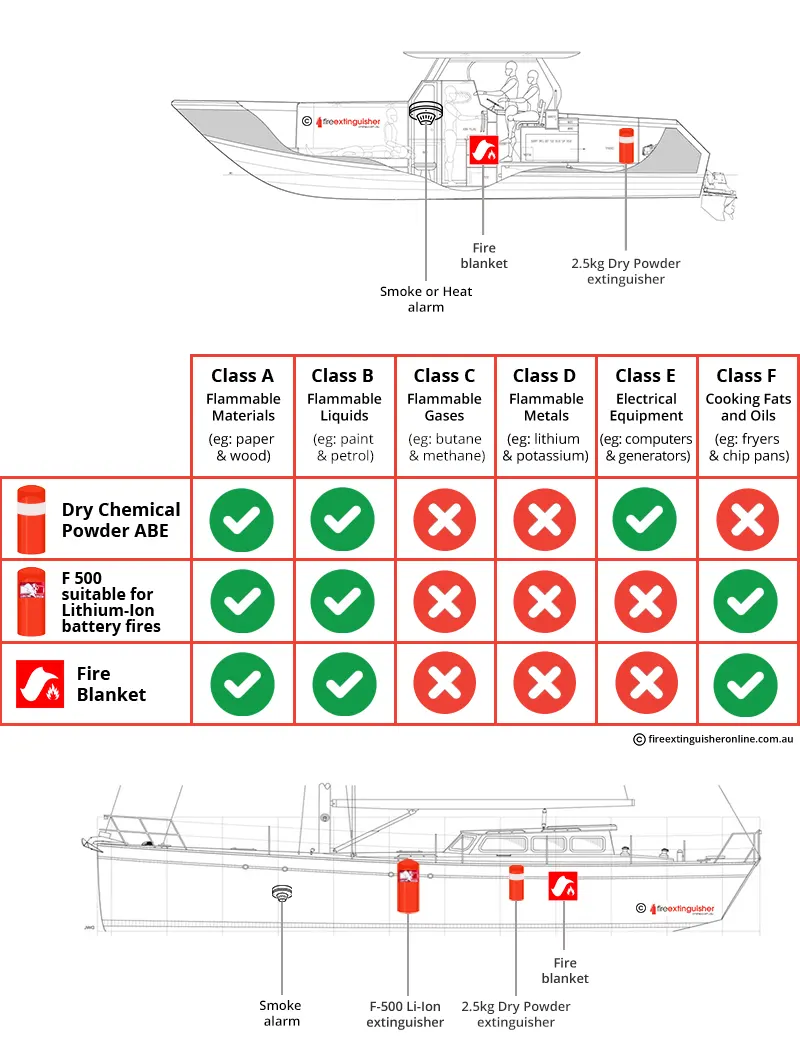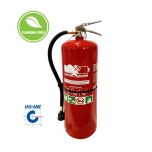Going on your Boat? Are you prepared for a Fire?
A fire can happen anywhere, even on the water, and it’s important to always be prepared for what you would do if you had one on your watercraft: sailing or fishing boat, ship, ferry, powerboat, yacht, dinghy, houseboat or trawler...
 It is mandatory* and a legal requirement in Australia to have at least one fire extinguisher in your boat (*depending on your boat type and sizes (vessel class B, C, D): vessels with electric start, electric motors, gas or fuel stoves). Of course, having the right safety equipment to protect your vessel against fire, such as a fire extinguisher is essential to protect your boat and passengers.
It is mandatory* and a legal requirement in Australia to have at least one fire extinguisher in your boat (*depending on your boat type and sizes (vessel class B, C, D): vessels with electric start, electric motors, gas or fuel stoves). Of course, having the right safety equipment to protect your vessel against fire, such as a fire extinguisher is essential to protect your boat and passengers.
Fire risks for boats and vessels?
- Engine & electrical fires:
While most modern-day boats are well-designed and very safe. they can still catch fire (Accidents, Electrical System Failure, Fuel System Leaks, Overheating Engine).
- Cooking fires:
Cooking in your kitchen's boat is also a cause of fire.
Remember once a boat is ablaze, it really doesn't matter what caused it. If your boat is on fire, if possible, get out fast and get as far away from the vessel, if not, try to extinguish the fire. It is more dangerous and difficult to extinguish a fire on a boat than on land. Boats can be quite small and hard to evacuate safely from.
What fire safety equipment should I have in my Boat?
Our recommended fire and overall safety products for your boat or vessel include:
- Fire Extinguishers*
- Fire Blanket in the kitchen area
- Smoke or Heat Alarm in the kitchen area
- First Aid Kit
- Life Jackets of course! * required for enclosed and open waters for class B, C, D vessels.
Which fire extinguisher is the best for my boat or vessel?
While there are a few different types of fire extinguishers (dry powder, water, foam, carbon dioxide, wet chemical), in our professional opinion, here is the best extinguisher set up for your boat:
For small & standard size boats (less than 8m long):
Inside the boat or cockpit, we recommend using at minimum a 1kg (carrying less than 115 Litres of fuel), or for added safety a 2.5kg dry chemical powder extinguisher (ABE) (carrying less than 350 Litres of fuel). It has good performance, a small gross weight and physical size so anyone on the boat can use it. It is a great multi-purpose fire extinguisher well suited for all types of vessels. (be aware: it leaves a mess and it is not eco friendly)
Also known as a Dry Powder, DCP or ABE, they are the most common type used in Australia and are labelled A, B, E, which tells you the types of fires the extinguisher is effective against. A is for ordinary combustibles like wood, paper, and cloth; B is flammable liquids, such as petrol, turpentine or paint; and E is for electrical fires (home appliances, computers...).
As ABE extinguishers are multi-purpose and cover 3 out of the 6 classes/types of fires, they are the best extinguisher solution for your boat or vessel.
For larger vessels:(between 8m and 15m long)
2 x Dry Chemical Powder extinguishers are required. The size and number of extinguishers will vary according to the size of the vessel and the amount of flammable liquid you are carrying, for example:
- 351-695 Litres: 2 x 4.5kg Dry Powder Extinguishers
- >695 Litres: 2 x 9kg Dry Powder Extinguishers
Solar boats with Lithium Ion Batteries:
If your boat is equipped with Lithium Ion Batteries:
we recommend a F-500 extinguisher, not only it can extinguish A, B, and F fires, it is also the first agent to extinguish Lithium Ion Battery fires. It also has zero impact on the environment.

Where to install your boat extinguisher(s)?
Boat or vessels extinguishers must be installed in easily accessible locations. If you place it in a remote area, you might not have time to get to it when needed. We recommend installing one near the cockpit, one in the kitchen. It is also important to securely mount the extinguisher (with short self drilling pan head screws) to prevent rolling around or sliding during a storm or an accident.
When you are on the deck, an extinguisher should also be accessible: you should mount a heavy duty vehicle bracket and install it at the back of your boat (with an extinguisher cover bag).
Installing the boat mounting bracket:
Since surface types vary, mounting screws are not included with our extinguishers and vehicle brackets. Please purchase screws or bolts specifically designed for the surface on which you will mount the fire extinguisher.
Use strong screws to mount the vehicle bracket securely onto metal or another solid surface that can support the weight of the fire extinguisher. The mounting bracket must be secure so you can remove the extinguisher quickly in an emergency.
Extinguishers above 4kg will need a heavy duty bracket.
How to use a boat Fire Extinguisher?
Knowing how to operate a boat fire extinguisher could save your life in an emergency.
The key to putting out a fire with a boat extinguisher is to use the PASS strategy: Pull the pin, Aim the hose towards the base of the fire, Squeeze the lever, and Sweep the hose.
Remember: Fires double in size every 60 seconds so use a fire extinguisher for small, contained fires only. Evacuate immediately if you're unable to extinguish the fire and call 000.
What to do If a boat fire occurs?
If your boat catches fire, you should immediately evacuate and never attempt to extinguish fires yourself.
if the fire is small and you are equipped with a boat Fire Extinguisher you can try extinguishing the fire.
- Get everybody out of the boat with life jackets.
- Call the fire service on 000.
- Do a headcount and let the fire service know if someone is missing.
- Remember Call triple zero (000).
Vessel sizes definitions:
Class A vessel means a vessel less than 5 metres in length not being a tender, canoe, kayak or personal watercraft.
Class B vessel means a vessel less than 8 metres in length but not less than 5 metres in length not being a canoe, kayak or personal watercraft.
Class C vessel means a vessel less than 12 metres in length but not less than 8 metres in length not being a canoe, kayak or personal watercraft.
Class D vessel means a vessel not less than 12 metres in length.
Enclosed waters means any port or inland navigable waters in Australia.


